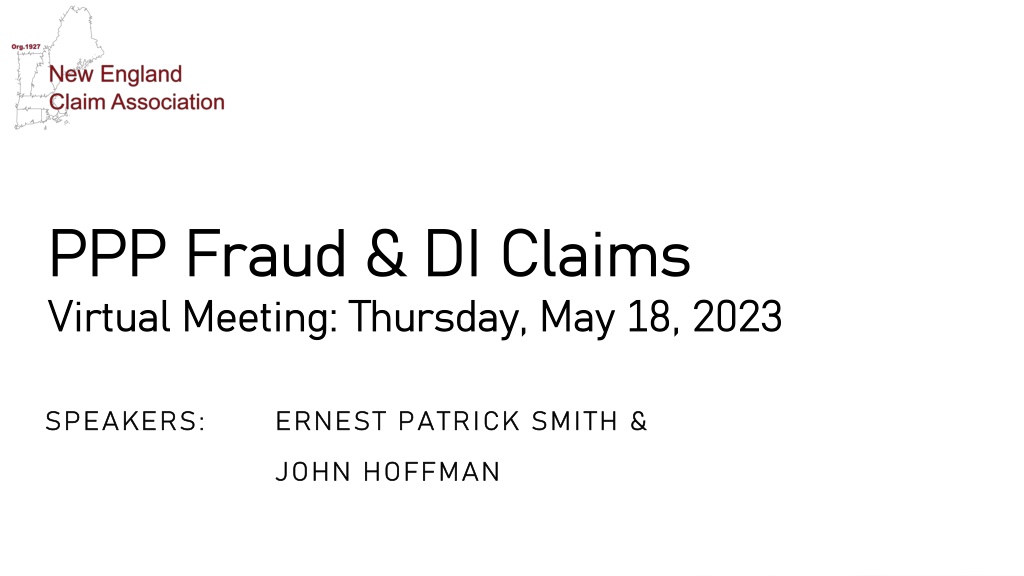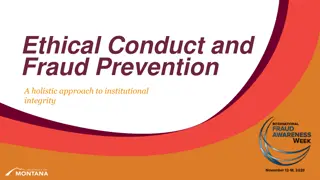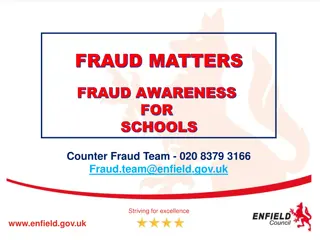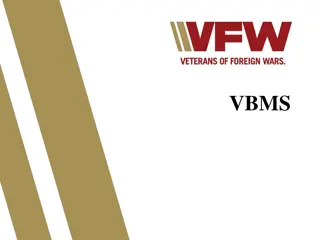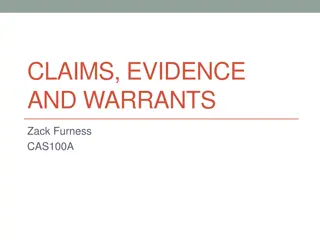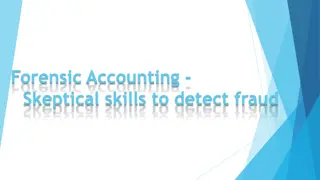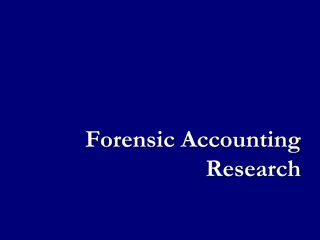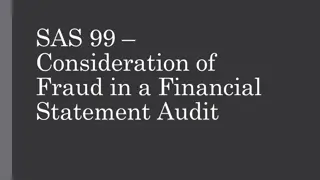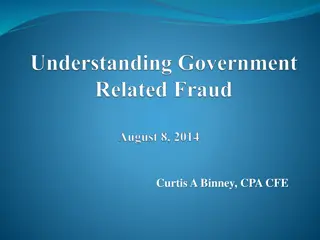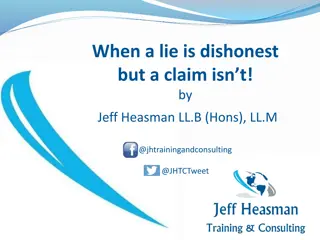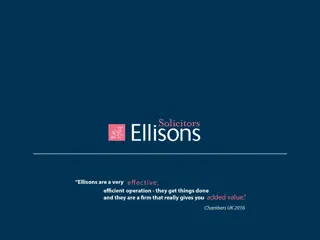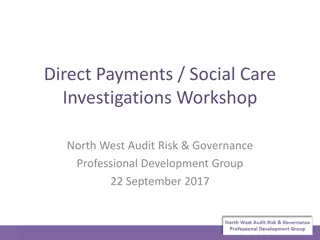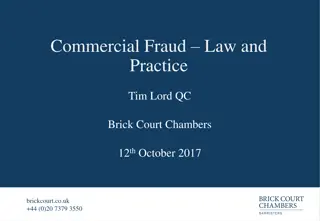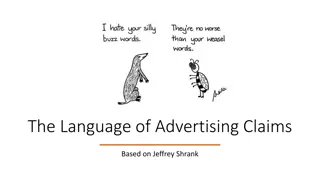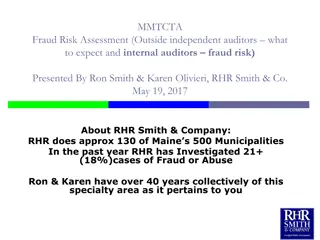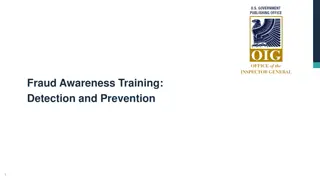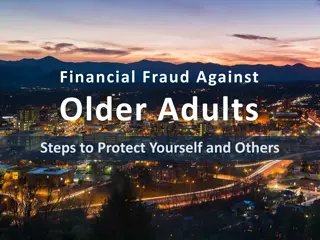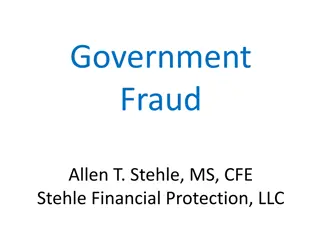Understanding Fraud in Financial Claims: Insights from Experts
Delve into the world of fraud and insurance claims with insights from renowned experts Ernest Patrick Smith and John Hoffman. Learn about the key elements of fraud, common definitions, and the intricacies of proving fraud, particularly in the challenging landscape of the California Department of Insurance. Gain knowledge on how intentional deception, false statements, reliance, and damages play crucial roles in identifying and prosecuting fraudulent activities in financial claims.
Download Presentation

Please find below an Image/Link to download the presentation.
The content on the website is provided AS IS for your information and personal use only. It may not be sold, licensed, or shared on other websites without obtaining consent from the author. Download presentation by click this link. If you encounter any issues during the download, it is possible that the publisher has removed the file from their server.
E N D
Presentation Transcript
PPP Fraud & DI Claims PPP Fraud & DI Claims Virtual Meeting: Thursday, May 18, 2023 Virtual Meeting: Thursday, May 18, 2023 SPEAKERS: SPEAKERS: ERNEST PATRICK SMITH & ERNEST PATRICK SMITH & JOHN HOFFMAN JOHN HOFFMAN
Ernest Patrick Smith, CPA/CFF/ABV, CVA, CFE, Ernest Patrick Smith, CPA/CFF/ABV, CVA, CFE, is a graduate of Hofstra University. He is a Certified Public Accountant and a Certified Fraud Examiner. Mr. Smith began his career with the Long Island Office of one of the world s largest public accounting firms. He has diversified experience in financial statement preparation, taxation, tax planning, internal auditing, investigative accounting, measurement of damages and litigation support services, with emphasis in matters dealing with business valuation, fidelity losses and fraud. He has extensive experience in succession planning and other estate, trust and tax planning services that pertain to the operations of small to medium sized companies. John K. Hoffman, CPA/CFF/CITP John K. Hoffman, CPA/CFF/CITP Partner with Nawrocki Smith LLP leading the Insurance Claims Consulting Group. He joined the firm of Nawrocki Smith in 1995 and provides insurance consulting, forensic accounting services, litigation support and risk management services. He has been recognized as an expert witness in disability- related litigation in both federal and state courts. Speaker Logo (optional)
Definition of Fraud (Many Definitions) Definition of Fraud (Many Definitions) Under common law Three elements are required to prove fraud: a material false statement material false statement made with an intent to deceive a victim s reliance reliance on the statement and damages damages. intent to deceive, Another frequent used definition Knowingly lie Knowingly lie with the intent to deceive someone relies relies on the lie and fraudster receives a benefit intent to deceive someone, benefit. Speaker Logo (optional)
California Department of Insurance (Hardest Place of Earth to Prove Fraud) California Department of Insurance (Hardest Place of Earth to Prove Fraud) Fraud occurs when someone knowingly lies to obtain a benefit or advantage to which they are not otherwise entitled or someone knowingly denies a benefit that is or someone knowingly denies a benefit that is due due and to which someone is entitled. According to the law, the crime of insurance fraud can be prosecuted when: The suspect had the intent to defraud. Insurance fraud is a "specific" intent crime. This means a prosecutor must prove that the person involved knowingly committed an act to defraud. An act is completed. Simply making a misrepresentation (written or oral) to an insurer with knowledge that is untrue is sufficient. The act and intent act and intent must come together. One without the other is not a crime. Actual monetary loss is not necessary as long as the suspect has committed an act and had the intent to commit the crime. Speaker Logo (optional)
Fraud Triangle Fraud Triangle Speaker Logo (optional)
What is a PPP Loan? What is a PPP Loan? SBA Loans issued to businesses during Covid-19 to keep their employees on the payroll. Application Process Forgiveness Process Determined Not to be Taxable Approximately $800 Billion of PPP Loans Issued (Program ended May 31, 2021) As of Jan. 9, 2023, approximately 92% of loans granted full or partial forgiveness. Who received the money? Who received the money? SBA Paycheck Protection Program Data Lookup - FederalPay https://www.federalpay.org/paycheck-protection-program (Use less search words to get best results) Speaker Logo (optional)
What is PPP Fraud? What is PPP Fraud? PPP fraud is the abuse of a loan program meant to cushion the blow for millions of Americans during the pandemic. More specifically, PPP loan fraud is when an individual or business submits false information when filling out a PPP loan application or when attempting to certify PPP loan forgiveness. Not surprising there is PPP Fraud Fast track loans approvals, easy to get, proceeds forgiven and not taxable Program seemed too good to be true Speaker Logo (optional)
So Called Trusted Professional case example (the largest dollar amount $44M of our examples) So Called Trusted Professional case example (the largest dollar amount $44M of our examples) THE UNITED STATES Department of Justice Office of Public Affairs FOR IMMEDIATE RELEASE Friday, February 17, 2023 Two More Defendants Sentenced to Prison for Multimillion Dollar Schemes Involving Preparation of False Tax Two More Defendants Sentenced to Prison for Multimillion Dollar Schemes Involving Preparation of False Tax Returns for Professional Athletes and PPP Loan Fraud Returns for Professional Athletes and PPP Loan Fraud Schemes Caused More Than $44 Million in Losses False Tax Returns filed for at least nine professional athletes more than $19 Million in tax loss Fraudulent PPP Loans (Seized $11.8 Million in PPP loan Proceeds and $5.6 Million in cashier checks) Speaker Logo (optional)
So Called Trusted Professional case example (the largest dollar amount $44M of our examples) So Called Trusted Professional case example (the largest dollar amount $44M of our examples) The Rudin brothers and Havana also prepared and submitted false applications prepared and submitted false applications for PPP loans on behalf of small businesses, shell companies, and other business entities they controlled, and took a fee of 30% of the fraudulent loan a fee of 30% of the fraudulent loan. They submitted fabricated tax returns to support the PPP loan applications applications, and some of the business owners never saw their loan applications before Mana Tax filed them. The loan applications grossly inflated the number of employees and monthly payroll costs. Some of the businesses had no payroll expenses and were not actually eligible for PPP Some of the businesses had no payroll expenses and were not actually eligible for PPP loans. loans. took fabricated tax returns to support the PPP loan During the investigation, the government seized more than $11.8 million of the fraudulent PPP loan proceeds from bank accounts controlled by the defendants. In addition, Havana surrendered cashier s checks totaling approximately $5.6 million, representing a portion of the fees charged to professional athletes for the preparation of their false tax returns and a portion of the fees taken from the fraudulent PPP loans. Speaker Logo (optional)
Everyone is being LOOKED AT case example Everyone is being LOOKED AT case example Even celebrities have been called out and investigated for fraudulent PPP loan frauds. This list includes celebrities from Kanye West (for his clothing and sneaker Kanye West (for his clothing and sneaker brand, Yeezy) brand, Yeezy) to Reese Witherspoon (for her clothing brand, Draper James). Reese Witherspoon (for her clothing brand, Draper James). West and Witherspoon have NOT NOT been found to be using their PPP loans fraudulently, but others have. Rapper and former Love & Hip Hop: Atlanta star Mo 17.5 years in prison and given a $4.4 million restitution bill. Mo Fayne Fayne was sentenced to The NFL's Josh Bellamy was arrested for participating in a PPP fraud scheme in which people applied for more than $24 million in loans. Speaker Logo (optional)
FLYING under the Radar case example FLYING under the Radar case example (the smallest dollar amount $3M of our examples) (the smallest dollar amount $3M of our examples) United States Attorney s Office Northern District of Georgia Thursday, January 19, 2023 Eleven (11) sentenced in connection with a $3 million Paycheck Protection Program fraud scheme ATLANTA Eleven and three from South Carolina, have been sentenced for their roles in obtaining approximately $3 million $3 million in Paycheck Protection Program (PPP) loans on behalf of ten and South Carolina. Eleven men, eight from the metropolitan Atlanta-area, ten businesses based on Georgia Speaker Logo (optional)
FLYING under the Radar case example FLYING under the Radar case example (the smallest dollar amount $3M of our examples) (the smallest dollar amount $3M of our examples) According to U.S. Attorney Buchanan, the charges and other information presented in court: Rodericque Thompson recruited Micah Baisden, Travis Crosby, Stanley Dorceus, Keith Maloney, Tabronx Smith, Mark Stewart, Timothy Williams, Thomas Wilson, and Kenneth L. Wright, Jr., to apply for fraudulent PPP loans on behalf of their respective ten (10) businesses: In exchange for approximately 50 percent of the loan proceeds 50 percent of the loan proceeds, Thompson helped each business owner obtain a $300,000 PPP loan by submitting fraudulent loan applications loan applications that contained numerous false and misleading statements statements about their businesses. numerous false and misleading Speaker Logo (optional)
FLYING under the Radar case example FLYING under the Radar case example (the smallest dollar amount $3M of our examples) (the smallest dollar amount $3M of our examples) For example, each of the loan applications claimed that the relevant business employed 16 individuals employed 16 individuals and paid monthly wages of $120,000 $120,000. Additionally, identical fraudulent quarterly tax returns identical fraudulent quarterly tax returns were submitted in connection with each loan application. After they received the funds, the business owners wrote payroll checks to individuals who did not work for their businesses individuals who did not work for their businesses and then either kept the money for themselves or gave the money to Thompson. They hoped to hide the fraud and expected to get the loans forgiven by writing payroll on the checks. writing payroll on the checks. wrote payroll checks to by Speaker Logo (optional)
DI CLAIMS (Pandemic Considerations) DI CLAIMS (Pandemic Considerations) Business Overhead Expense Business Overhead Expense PPP Loans Designed to pay for payroll, group benefits, retirement plans, rent and utilities. Should the policyholder be paid by BOE policy, if the expenses are being paid by the government and not the policyholder? Speaker Logo (optional)
How do we address losses due to pandemic and pandemic funds received? Prior Monthly Income Look Back Period for Calculation Just Prior to Disability, Prior 12 Months, Best 2 of 5 years, Best 1 of 3 Years How do we deal with losses from pandemic in look back period? How to deal with pandemic causing a low PMI? Speaker Logo (optional)
Current Monthly Income Verifying Loss is Due to Disability (Loss of Earnings due to Shut Down of US Economy/Post Covid Impacts (March, April, May, June 2020 .) Should pandemic funds received be included as income? For employees? For self-employed? Speaker Logo (optional)
Group (LTD) Offsets Group (LTD) Offsets Expanded Paid Sick Pay, Family Medical Leave, Unemployment (Federal & State), Stimulus Checks, PPP Grants, Employee Retention Credits (ERC)etc. (Policy intended is to make claimant whole when considering prior earnings) (Free Money from Government may go beyond making some people whole) Speaker Logo (optional)
Individual Disability Policies Individual Disability Policies Should pandemic funds be included as income for CMI? Sample Earnings Definition Speaker Logo (optional)
All policies require the loss to be due to disability Speaker Logo (optional)
All policies require the loss to be due to disability Speaker Logo (optional)
Should we include pandemic funds in current monthly income? For IDI claims? For Group claims? Per policy loss of income needs to be due to disability. Did pandemic cause the loss or disability? Argument can be made there is no loss as government stepped in to provide relief for any losses during the pandemic. Speaker Logo (optional)
Bonus Material Bonus Material Earnings or Investment Earnings or Investment Passive vs. Non Passive vs. Non- -Passive Passive 2 2 2 2
Earnings or Investment Earnings or Investment How is income (loss) reported on tax return? How is income (loss) reported on tax return? Employee (Form W2) Wages & Employer Pension Contributions Sole Proprietorship/LLC Schedule C (Form 1040) Net Profit (Loss) Partnership/LLP (Form 1065) Guaranteed Payments & Ordinary Business Income (OBI) S Corporation/PC (Form 1120S) Officers Comp (W2) & Ordinary Business income (OBI) Corporation (Form 1120) Officers Comp (W2) & Taxable Income before NOL (Investment Income Interest, Dividends, Capital Gains (Loss)) 2 3 2 3
Earnings or Investment Passive v Non-Passive Income (26 U.S. Code 469 - Passive activity losses and credits limited) Does the Insured Materially Participate in the business activity? Establishing Material Participation Establishing Material Participation Considered materially in an activity if meets one of seven participation tests: four-time tests, two long- standing (or look-back ) tests, or a seventh residual facts and circumstances test ( 1.469-5T(a)(1)-(7)). Tax Rules very complex and provide us guidance when considering if earnings under the policy definitions. 2 4 2 4
Earnings or Investment How How to determine to determine materially participate (MP) using any of the seven tests materially participate (MP) using any of the seven tests. An individual materially participates in an activity if they and/or their spouse: 1. Works 500 or more hours in the activity. 2. Does substantially all the work (i.e., more than 70% of the total business hours for the year are performed by the owner). Substantially all includes services of nonowner employees. 3. Works 100 hours, and no one else does more. 4. Works 500 hours in all businesses owned. The individual is deemed to materially participate when the activity is a significant participation activity (SPA) for the taxable year, and the individual s aggregate participation in all SPAs during such year exceeds 500 hours. 5. Materially participates in the activity for five of the last 10 years (whether or not consecutive) during the 10 taxable years that immediately precede the taxable year. 6. Participates in a personal service activity with three years of participation. Individual materially participates in a personal service activity (e.g., accountants, lawyers, doctors taxable years (whether or not consecutive) preceding the taxable year. 7. Proves facts and circumstances. Based on all of the facts and circumstances, the individual participates in the activity on a regular, continuous, and substantial basis during the tax year. doctors, etc.) for any three 2 5 2 5
Earnings or Investment Hobby Loss Rules Can Also Help to Determine if Engaged For Profit and Earnings under the policy. 9 Factors IRS use to Determine Profit Motive 2 6 2 6
Earnings or Investment IRS factors used to determine profit motive. IRS factors used to determine profit motive. Whether or not an activity is presumed to be operated for profit requires an analysis of the facts and circumstances facts and circumstances of each case. Neither the Code nor the Regulations provides an absolute definition absolute definition. As a result, deciding whether a taxpayer operates an activity with an actual and honest profit motive typically involves applying the nine nonexclusive factors contained in 1.183-2(b). These factors are as follows: 1. The manner in which the taxpayer carried on the activity. 2. The expertise of the taxpayer or his or her advisers. 3. The time and effort expended by the taxpayer in carrying on the activity. 4. The expectation that the assets used in the activity may appreciate in value. 5. The success of the taxpayer in carrying on other similar or dissimilar activities. 6. The taxpayer s history of income or loss with respect to the activity. 7. The amount of occasional profits, if any, which are earned. 8. The financial status of the taxpayer. 9. Elements of personal pleasure or recreation. No single factor controls and the factors do not do not have equal weight, meaning the mere fact that the majority of factors indicate a profit objective exists (or vice versa) is not conclusive. For example, if five factors say the activity is not for profit, but four are on the profit side, the activity still could be determined to be engaged in for profit. 2 7 2 7
Earnings or Investment Some Factors NAWROCKI SMITH Consider to Determine Earnings or Investment: How is income reported on tax return? What is the Insured s ownership percentage and control of business? Passive vs Non-Passive on tax return Is there a For Profit Motive? Historical Income (Loss) from activity Insured s experience, training, education (CV) Marketing & Promotional Material Website Is the Insured mentioned on website? Bio? Linked In Is the business indicated? Consider Descriptions? Business Cards? Does the Insured have an email account for the business? Does the Insured have an office/desk at the business location? Does the Insured have regular business hours at the business? Does the Insured have time to devote to business when considering other possible occupations? The Insured s descriptions of his involvement, duties, activities and responsibilities related to the business operations. 2 8 2 8
Ernest Patrick Smith CPA/ABV/CFF, CVA, CEPA Ernest Patrick Smith CPA/ABV/CFF, CVA, CEPA (631) 756-9500 x 223 C: (516) 659-5151 epsmith@ns.cpa THANK YOU John Hoffman, CPA/CFF/CITP John Hoffman, CPA/CFF/CITP (631) 756-9500 x 228 C: (631) 834-2695 jhoffman@ns.cpa Speaker Logo (optional) 2 9 2 9
